
The first time I ever came in contact with the Swedish label Really Fast Records was when a punk kid bought one the their first compilation LP’s and showed it to me. I was an aspiring drummer for a few years at that time but I never really perused that path. The later was probably a good thing for punk connoisseurs, as I sucked. But the label name “REALLY FAST” did intrigued me. I liked fast music, still do! Looking at the poster sleeves on the early releases, I thought the bands had really weird but cool names like: Tatuerade Snutkukar (Tattooed Cops Dicks), Kurt i Kuvös (Kurt In incubator) and P-Nissarna. The later sound like the Penises in Swedish. That inspired us to form a band called Al-kisarna (impossible to translate).
Really Fast Records had a large influence on the Swedish Hardcore scene by their series of Really Fast Compilations . As a label they were also a channel to the international market. Really Fast Records was formed by Patrik Jonsson, Staffan Fagerberg and Peter Pinaitis in late 1981.
So, Patrik Jonsson (one of the founders of Really Fast Records), how did it all start?
Patrik : I have my origin in the 77-punk so there is the punk background. I lived in Mjölby and played bass in Nasty Boys. We actually cut a vinyl, seems to be a collector item these days which I don’t understand because it quite bad. Anyhow, Staffan (Fagerberg) played drums in Kurt i Kuvös from Skänninge, not far from here. He was three years younger than me, 14 years old at the time and had a fanzine called Sub. He wanted an interview with Nasty Boys and that is how we first met, in spring 1981.
Image to the right: Staffan’s fanzine “Sub”.
And You guys decided to start a record label?
Patrik Ha ha – well in the autumn of 1981 me, Staffan and Peter Pinaitis who played guitar in Nasty Boys started talking about releasing a compilation record. I just mentioned that Staffan had a fanzine and I and Peter also had one called Zäta. We had some contact with other bands through the zines but also as our bands played at shows with other bands. This was in 1981 so most bands played 77-style punk. As we were working on the compilation record the old bands dropped out and the new stuff that we liked was hardcore type of bands, or “Råpunkband” as we called them. Eventually everyone seemed to play hardcore.
Image to the left: RTS / Asocial split tape.
The first record came in 1983 and meanwhile you guys put out tapes, right?:
Patrik: Yes, as I said the record took forever. In 1981 I was still in school and I was reading music magazines in the school library. I saw in Schlager that you could order tapes by the length of your choice and by so I got the idea to issue tapes. The first one was my own solo project and it was released in 1981. Together with Staffan and Peter we started to release more tapes. When we decided to make the tape we designed the sleeves but the tapes was copied as we got orders. We used generic stickers that came from the tape company.
So what was the red thread with the tape releases?
Patrik : I don’t think it was much of a plan, just did the stuff we liked. We made a tape and then we made the next one. Many bands were from the Östergötland regions (editor’s note: between Stockholm and Gothenburg), some were bands we played in, we made splits with demos we got from bands, compilations tapes and live recordings like the Fanx 1 and 2. And by live I mean that we taped the concert with a tape recorder and then edited the tape. Staffan made some really good tapes that were nice done in the DIY culture we had. I remember that he made a Danish compilation tape that was a quite serious release.
How did you sell the tapes?
Patrik Most of the tapes were sold at gigs. There were a lot of shows at the Arbis Theater and at Skylten in Linköping. This was also the days when there were conserts at the “Fritidsgårdar” (public youth centers). We sold some through mail order, but these orders were mainly from people who met us and didn’t have cash at the time. We did not do much marketing. I can’t remember we ever had an advertisement in a fanzine or something. Staffan might know, I was not much into zines myself.
Image to the left: Patrik in the front Nasty Boys (1981). In the rear Peter “Pinnen” Pinaitis.
And how did Really Fast make the actual tapes?
Patrik I bought a double deck tape recorder quite early, a Technics which I paid 3,000 Swedish krona (SEK) for. That was a lot of money at that time. So we just copied the tapes we needed. The good thing was that you could copy in double speed with this tape deck. Despite that we made many different releases (more than 24 tapes – editor’s note) the total number of tapes per release was quite low compared to today’s standards. A few releases were only sold in 3 copies, like Satelliterna and my own project Dödsdömd. The “best seller” was the Asocial / RTS split, about 40 tapes I guess. But there was a lot of tape trading at the time and people made much more copies. We also released some non punk tapes which I guess are the ones that are hardest to find today – if anyone is looking.
Really Fast made tapes until 1984?
Patrik : Right!
Image to the left: The first compilation LP – Vol. 1 (1983).
And the first record was released in 1983 – what is the story behind that?
Patrik Well, we had the idea about a compilation record already in 1981, but it took some time to get in contact with all the new bands. We didn’t have any money neither! The record was released on Really Fast but all the bands that were on the record actually chipped in money and got records in return. I think every band got 50 records except Huvudtvätt (Headcleaners) that took 100 copies. It was DIY all the way as we did not know so much about making records. Some of us had a little experience as Nasty Boys made a 7 inch. We did not understand how to put together a record. No band provided any reel-to-reel tapes, it was all cassettes. Mats Nilsson (Huvudtvätt) lived in Linköping and he had some experience as he used to release records on Massproduktion when he lived in Sundsvall. He knew a guy who had a 4 track reel-to-reel tape recorder.
We did not know much about the technology so started to copy the cassettes to the reel-to-reel and made pauses between the songs so it would fit one side a 12 inch record. Then we turned the reel and recorded the other side. Europa film was going to cut the lacquer and they called us and said that it sounds like there are two songs on the master tape at the same time, one is played backwards. Ha ha – we did not really have any idea what we were doing! If you listen to the record you will notice that the Sune Studs och Grönlandsrockarna’s song just ends suddenly. I don’t remember if we made a mistake or the recording we got from the band was like that. Well it ended up on the record like that.
Image to the left: Front sleeve of MRR issue 9 (1983).
That’s punk right! The sleeve was kind of Crass inspired
Patrik Yes, that’s right – we were all into Crass. We bought a large black sheet of paper and basically made poster sleeve using glue and a pair of scissors. We printed all sleeves at once. Go got a contact through Sixten at A Records and the sleeves where printed at a left wing trade union in Gothenburg . The record was first pressed in 1,000 copies and later we pressed 600 records because we had 600 extra sleeves. Despite all issues with the records, we learned quickly how to make a record. I was 19 yars old at the time and Staffan was 16 when the first record was released.
How did you guys sell the record?
Patrik : We sold the records at shows as we did not have a distro in the beginning. The first years we did not have much contact with the other labels, mainly because it did not really existed so many labels releasing hardcore. We had contact with Mats Bodenmalm quite early and also with Vote Vasko in Finland. His label, P. Tuotanto was early putting out hardcore records (editor’s note – Later Johanna). If you look at the international hardcore scene it was mainly about bands from UK and to some extent Finland. I believe Sweden was not really known at the time. Few bands had released records in Sweden. Huvudtvätt was early, Shitlickers put out their EP in 1982 and a handful more bands cut vinyl. Of some reason MaximumRocknRoll in USA made a scene report of Swedish punk. Someone had sent them our first compilation, I don’t know who but Mats (Huvudtvätt) is the prime suspect. It got good attention and the record was referred as the Really Fast vol. 1. The title is actually only Vol. 1. Anyhow – after that it got crazy and we started to sell and trade a lot of copies abroad. By that time the hardcore scene had exploded in Holland, Italy, Germany and other parts of Europe. It also connected us to the US hardcore scene – before that I was not aware of that happened in the States.
Short review from MaximumRockRoll # #9 Oct/Nov 1983.
The price for the record was only 20 SEK, about the same price as for a single?
Patrik Yes that was the idea. A record for the price of a single!!! We did not do it to make money. The price was more or less the costs to make a record. That has been our DIY idea all the time. I mean – we put out 28 records but we never made any money, we did not have any written contract with the bands. I mean the bands were part of it as they put in money and got records in return. To be honest – there is no company in legal sense. It was mere a hobby.
Regarding contract – there was some issues with Anti-Cimex, right?
Patrik : Yeah – the Raped Ass press! We heard that A-records were out of copies that they were not going make a second press. We thought that was sad so we were in contact with Sixten (editor’s note – Sixten Andersson, who later played bass in Anti-Cimex as well) at A-records and asked if we could make a press. That was okay by him. We also spoke with Jonsson in Anti-Cimex at a gig and he said – hell yeah!!! I believe he was quite drunk when we asked him so we followed-up that with a confirmation by phone. Sixten arranged so we got the master disc and we pressed 300 copies. The idea was to sell them for 5 SEK each to distros and they would sell them for 10 SEK. I remember that the cost to press them was 3,50 SEK and the difference, 1,50 SEK, was basically the postage. Anyhow – when the record came out some of the guys in Anti-Cimex were really pissed off and claimed we did not have the rights and that we ripped them off. But – you know – we thought we had deal and we also thought it was a good thing that more records came out. There was alot of people that liked it but could not buy it as there was no second press. It’s a great record, by the way!
Image to the left: The Anti-Cimex – Raped Ass press – sleeve without the violin (1980), 30 copies made. Click on the image for hihger resolution.
You had some issues with the sleeves also?
Patrik Yes – we made a sleeve and Staffan and my brother Magnus (who played drums in S.O.D) copied them at their school on a lousy machine. The sleeves were really pale. After 30 copies, the guitarist of Kurt i Kuvös draw a violin on the sleeve and they made 120 more sleeves with that. On top of that they left the original on top of the locker and I guess the cleaning lady found it and threw it away. So for the final 150 sleeves we just xeroxed the original A-records artwork as a two piece sleeve.
And now this stuff is collector items and people pay shitload of money for a sleeve without the violin. What do you think about that?
Patrik I can find the high prices of some records not being very much punk, it’s the opposite of our non-profit idea. On other hand I can understand the prices among collectors, some releases was pressed in very few copies. But it has gone insane with today’s prices. For those of us that bought this stuff in the early / mid 80’s we have some money saved for the pension, ha ha. I have stopped buying old records that I lack for my collection. Frankly -I feel it is better to spend money on bands and labels of today and by so supporting the scene.
The first compilations can go for 150 dollars if it is in nice condition. A collector paid close to 1,000 dollars for an Anti-Cimex sleeve without the violin released on Really Fast. Due the few copies presses of some releases it’s not uncommon that early 80’s hardcore records go from 100 dollars up to 500 dollars and even more.
Are record collectors are pretentious assholes?
Patrik Ha, ha – I collect records myself but I have made my statement!
Scene report on Sweden in MMR #9 – click on the image to read the full article.
Back to the first record, Rosa Honung released a compilation about the same time?
Patrik Yes! “Vägra för Helvete” came about the same time. The price was 40 krona, double our price. It’s a good compilation album.
Double price – so they sold out?
Patrik In those days some people thought so. But frankly – we did not make a dime – no profit was our concept. Maybe Rosa Honung made some money which was used for later records, I don’t know. Stuff like this is in the light of history not to important now.
Did Really Fast Records interact with the other Swedish punk labels?
Patrik I would start with saying that we did not view ourselves as a label, really. Due to the nature of the deals with the bands we were more co-coordinators. But for the other labels: We had Skvaller Records in Jönköping which is not too far from here and we had contacts with them. Birdnest was from Köping, Per Granberg was singing in Charta 77 and started the label by issuing their first record, Välfärdens avfall, I guess. And we had the guys in Gothenburg that put out the Shitlickers and Anti-Cimex records. And Mats Nilsson put out records on Massproduktion when he was in Massmedia but I did not learn to know him until he moved to Linköping to study. Later Babs in Fagersta converted his fanzine “Uproar” into a label. I believe their first release was the Crude SS EP. We traded records with each other and by so had a distro as well.
What about Malign Massacre records in Uppsala, they put out some of the Headcleaners and also Shitlickers right?
Patrik Yes, they made the re-press of Shitlickers and also the third Anti-Cimex EP “Victim of a Bombraid”. I always thought it was Mats Nilsson’s label but I read somewhere it was the label of the first Headcleaners singer. Got to ask Mats about it!
The hardcore labels Denmark and Norway came little bit later, but the Finns put out records early!
Patrik Yeah, they were early – as I said earlier it’s to some extent much thanks to Vote Vasko that had P. Tuotano. We traded records with them early. In Norway it was mainly X-port Platter (editor’s note – the label was managed by the vocalist of Svart Framtid). Otherwise we were dealing with labels outside the Nordic countries through our distro. It was much because of the MaximumRocknRoll article.
Image to the left: Kurt i Kuvös (1983), Staffan is in the middle.
Really Fast Records was active in the Östergötland region which had a lot of hardcore bands including SOD, Raped Teenagers, and Rövsvett (technically from Tranås). As a few bands started the scene possible got critical mass to grow. With venues to play and bands exchanging members, the scene was maintained in the 80’s and into the 90’s. The region had also some bands from the first 77 wave that gave the second wave some momentum. A similar hardcore movement happened in Gothenburg in the early 80’s and in Umeå in northern Sweden in the 90’s.
As for Patrik, when not putting out records he played in Kurt i Kuvös, had a studio project with RTS (Red-Tape Trash Survey) which made two demos. He also and worked on his solo noise project “Dödsdömd” and was in another experimental act called Satelliterna. That’s not all – he played in Drugstore and Union, which put out records on Really Fast Records, and some other bands including a post-punk band and a “deathstonerband”. Peter was active musician in several bands as well and Staffan also played in many bands. Staffan is currently found in Spotlicks.

Image to the left: Staffan Fagerberg of today – Still DIY!!!.
Really Fast Records released few records with Stukas?
Patrik Yes – Staffan liked them as a live band and thought they had to be on vinyl.
Really Fast is a cool name – how did you come up with that?
Patrik First we called us Fast Records but there was another label called that. So we thought, what is faster than fast – well Really Fast, ha ha!!
You put out 28 records but it all stopped in 2002, what happened – did you get old and tired?
Patrik We might get old but for sure not tired. We released a record after that with Spotlicks, Staffan’s band. But we thought it was time for the kids to take over.
But it is quite long hiatus! I beleive it was more to it!
Patrik I’m afraid this might sound a little bitter, but Nirvana destroyed everything, ha ha! First of all, already in the mid 90’s no-one bought records, we made some CD’s, but we really like records. That might be what makes us old these days. The other thing was more serious. With the new “punk” bands like Green Day and the bands that came after the grunge wave – everyone seemed to strive for being superstars. Our idea is to make a record for the band, giving them an opportunity put out their music. However – the kids wanted to be “signed” and that was not really our way of working: We are true to the DIY culture. It was even hard to get bands for the compilations records because bands wanted money upfront. On top of that both I and Staffan had to deal with some private shit, which meant we lost energy for Really Fast for a time.
Image to the left: Illustrative image of non-punk sell-outs.
I don’t think that is being bitter, it was more the punk scene moving in the wrong direction, right!
Patrik You are right, today it’s more back to what punk is all about. The kids are putting out records, publish music on the net and there is a lot of good distros. From that perspective the DIY have never been stronger.
And you guys were the pioneers?
Patrik Maybe, but I don’t really see it like that. Today when history is written, some say that. I believe there are some inflated statements out there. In reality we were kids doing what we thought was fun. Obviously the bands influenced a lot of people and that helped to grow the scene. Really Fast was there to support it, that’s all! I will not accept any major credit
Scandinavian modesty?
Patrik You call it what you like!
Image to the right: Patrik Jonsson today. Keeping an eye on former Soviet Union punk.
But Really Fast Records are in the planning to put out records again?
Patrik That’s right – We plan to release Red-Tape Thrash Survey, originally planned for 1984 so we are quite delayed!
Thanks Patrik for the interview – when can we expect that next compilation record?
Patrik We are making a compilation with bands from former Soviet Union. We have found a lot of bands in Azerbaijan, Belarus, Kazakhstan and Uzbekistan that are great and that deserve a better distribution and a larger audience.
Back to basic, right!
Patrik Yes – as always

Peter Pinaitis was involved in the label until the first compilation record. Patrik’s brother, Magnus, was working with Really Fast between 1984 and 1988. Patrik and Staffan is still running the label. Of the 28 released Really Fast Records has done until this interview, 10 of them are compilation records. Certainly the first ones inspired me and helped me to find out about new bands. Being a punk kid it was of course a dream to be cut on vinyl and for some Swedish bands Really Fast was there to fulfill the dream. It might not be so that Really Fast Records changed the world but as a label with their Do It Yourself attitude they contributed to the Swedish scene and took part in linking it to the international scene. Today’s it’s easy to distribute music through the internet whilst getting recognitions is as difficult as always. Certainly the record format plays a limited role these days when everything can be downloaded. However – a good compilation release can guide punk fans to new bands. For me it makes sense that Really Fast plan to release bands from countries that have not put out much records. It might be so that the physical record format is of less importance and that it’s more important to have a co-ordinating “labels” like Really Fast Records to break through the information noise these days. Despite that it have been been 30 years since the guys started their label, they still play a role. I hope to see more records going forward.
Sundsvall, Sweden February 2013, the editor

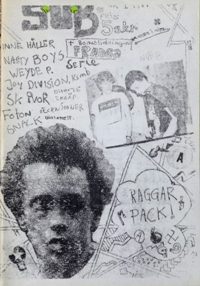
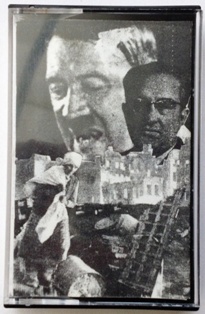
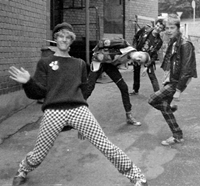



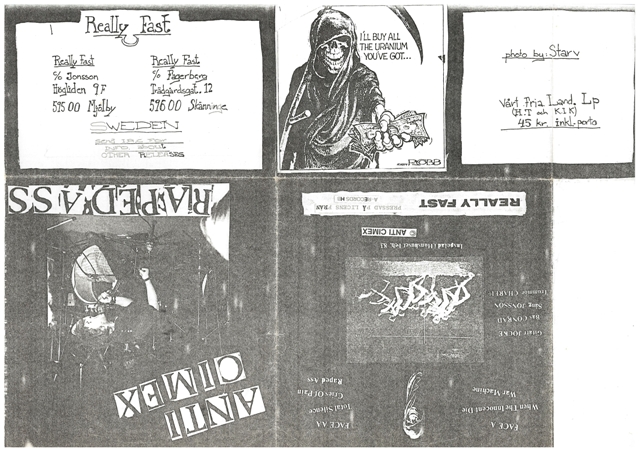

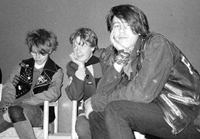


I always try to find the really fast number 2 but is very scarf!! there is some one who want to exchange with me colombian stuff by swedish.
Really fast 23 (Really fast volume 1,2,3 compilation) should be pressed and available again. Essential punk!
oh!!!!!!!!!!1 sounds great can you help me with the really fast 2….and how many cost with mail until colombia in south amarica.?